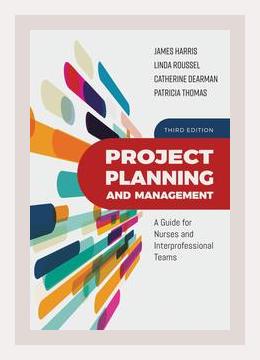Operations and Supply Chain ManagementProject Management
**
Introduction:
James L. Harris’s “Project Planning and Management: A Guide for CNLs, DNPs and Nurse Entrepreneurs” offers a comprehensive approach to project management tailored specifically for clinical nurse leaders (CNLs), Doctor of Nursing Practice (DNPs) graduates, and nurse entrepreneurs. This book bridges the gap between nursing practice and project management principles, preparing healthcare professionals to lead and innovate effectively.
Chapter 1: Foundations of Project Management for Nursing Professionals
– Key Points:
– Introduction to project management basics tailored for healthcare settings.
– Importance of understanding project life cycles and the differentiation between project types.
– Example: The book describes a scenario where a hospital needs to reduce patient readmission rates. The project cycle includes initiating the project, planning, executing, monitoring, and closing.
– Action: Nurses can start by identifying a core problem within their practice area that needs addressing, such as patient readmission rates, and define clear project objectives and outcomes.
Chapter 2: Developing Project Plans
– Key Points:
– Detailed guidance on creating a structured project plan, including scope, objectives, and deliverables.
– Emphasis on SMART (Specific, Measurable, Achievable, Relevant, Time-bound) goals.
– Example: A nurse-led team aims to reduce medication errors by 20% within six months through a new double-check system.
– Action: Draft a project plan with SMART goals, clearly define the project scope, and outline each deliverable. Ensure that every team member understands their role within the project.
Chapter 3: Effective Team Building and Leadership
– Key Points:
– Strategies for building cohesive project teams with diverse skills.
– Leadership styles and their impact on project success.
– Example: A CNL forms a cross-functional team consisting of pharmacists, senior nurses, and junior staff to address medication administration errors.
– Action: Assemble a team with complementary skills and regularly hold team-building activities to foster collaboration and trust.
Chapter 4: Resource Management in Healthcare Projects
– Key Points:
– Managing resources such as personnel, time, and budget efficiently.
– Strategies for avoiding common pitfalls in resource allocation.
– Example: A DNP project allocates budget resources towards new software for electronic health records (EHRs) to enhance patient data accessibility and reduce clerical workload.
– Action: Create a detailed resource management plan that catalogs all necessary resources, estimates time and budget, and includes contingency plans for unexpected challenges.
Chapter 5: Risk Management in Healthcare Projects
– Key Points:
– Identifying, assessing, and mitigating risks in project management.
– Importance of developing a risk management plan.
– Example: Implementation of a new patient triage system requires anticipating risks such as technology failures or staff resistance.
– Action: Conduct a risk assessment for your project, categorize potential risks by severity and likelihood, and develop mitigation strategies to address each risk.
Chapter 6: Communication Strategies for Project Success
– Key Points:
– Importance of effective communication within and outside the project team.
– Techniques to facilitate clear, concise, and consistent communication.
– Example: Regular updates and briefing sessions help ensure that all stakeholders are aware of progress in a new patient care protocol project.
– Action: Establish a communication plan that includes regular meetings, progress reports, and clear channels for feedback and issue resolution.
Chapter 7: Implementation and Execution of Projects
– Key Points:
– Steps for turning plans into action and ensuring successful project execution.
– Monitoring and controlling processes to keep the project on track.
– Example: Execution of a fall prevention program in a nursing home, including staff training sessions, installation of safety equipment, and regular audits.
– Action: Develop an implementation schedule, ensure all resources and personnel are ready, and use project management tools to monitor progress and make necessary adjustments.
Chapter 8: Evaluation and Closing of Projects
– Key Points:
– Methods for evaluating project outcomes against initial objectives.
– Importance of documenting lessons learned and successful closures.
– Example: A nurse-led initiative to introduce a new infection control protocol undergoes extensive evaluation through patient infection rate audits.
– Action: Conduct a post-project evaluation by comparing the outcomes with initial goals. Document what worked well and what didn’t to inform future projects.
Chapter 9: Case Studies and Real-World Applications
– Key Points:
– Real-world examples of successful healthcare projects led by CNLs, DNPs, and nurse entrepreneurs.
– Emphasis on best practices and innovative solutions.
– Example: A case study on a DNP-led telehealth project from planning through execution and its impact on rural patient access to healthcare.
– Action: Analyze case studies relevant to your area of interest to understand practical applications of theoretical concepts. Apply the lessons learned to your projects.
Chapter 10: Tools and Techniques for Project Management
– Key Points:
– Overview of project management tools like Gantt charts, flowcharts, and software applications.
– Importance of choosing the right tools and techniques for your specific project needs.
– Example: Use of a Gantt chart to manage timelines and milestones for a quality improvement project in a clinical setting.
– Action: Select appropriate project management tools to plan, execute, and monitor your project effectively. Get trained or seek resources on using these tools proficiently.
Conclusion:
James L. Harris’s guide offers actionable insights and practical tools tailored for the nursing field, emphasizing that effective project management can drive significant improvements in healthcare settings. By following the thorough approaches and strategies laid out in this book, nursing professionals can lead projects that yield tangible benefits for patient care and operational efficiency.
In summary, Harris’s book serves as a robust resource for CNLs, DNPs, and nurse entrepreneurs, helping them navigate the complexities of project management in healthcare environments. From planning and team building to execution and evaluation, every chapter is packed with real-world examples and actionable advice, making it an essential read for nursing professionals aiming to lead successful healthcare initiatives.
